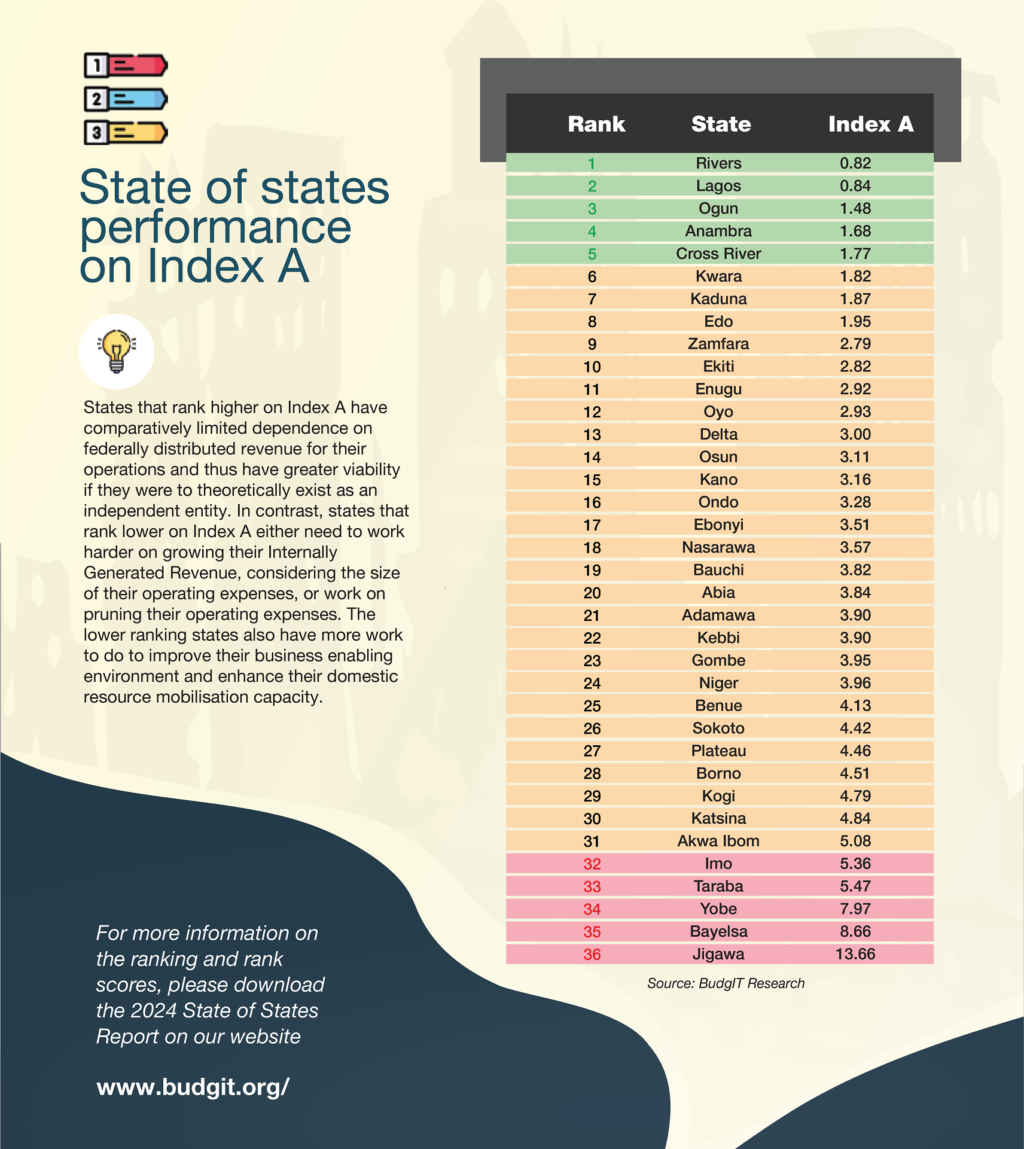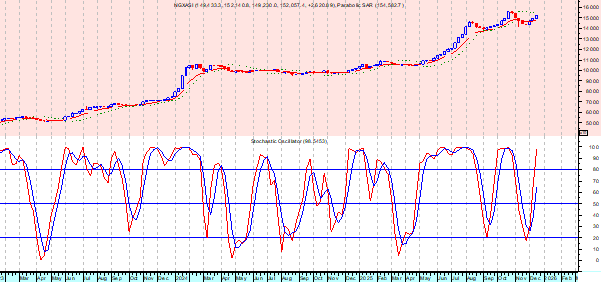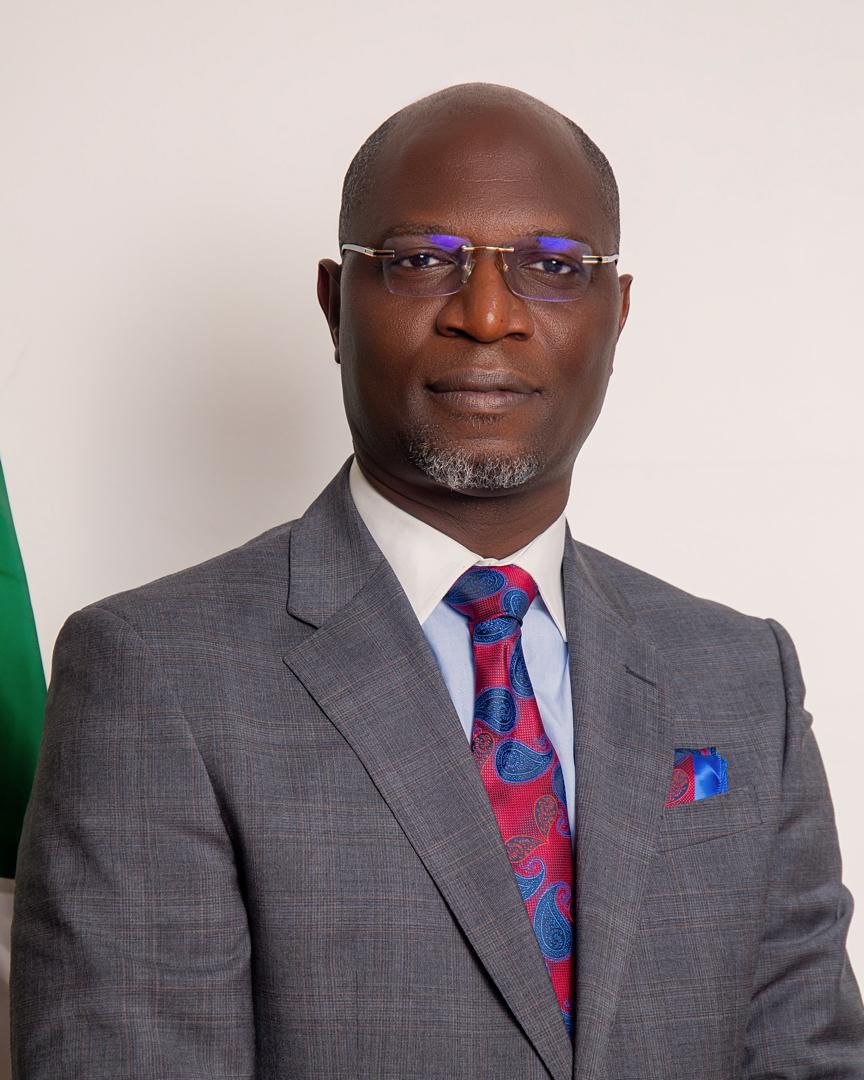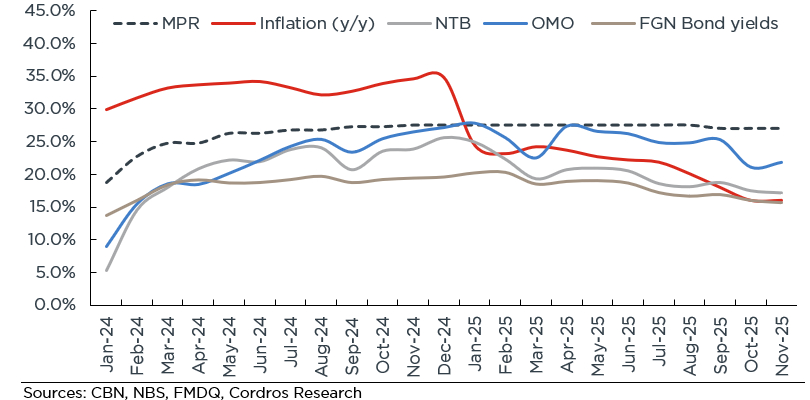
- Lagos, Anambra Stay In League
BudgIT, a prime civic-tech organisation, on Tuesday, October 29, 2024 unveiled the 2024 edition of its annual State of States Report, a sustainably assessment and ranking of the fiscal performance of Nigeria’s 36 States
The 2024 report, BudgIT’s flagship research product, saw a reshuffling of top positions in the fiscal performance ranking, as Cross River joined the league of top five of which Rivers State maintained the top spot.
Rivers and Lagos were the only two states that generated more than enough IGR to cover their operating expenses, with IGR to operating expense ratios of 121.26% and 118.39%, respectively.
Kebbi State, according to a statement by Nancy Odimegwu, Communications Associate, achieved the most remarkable improvement, jumping 12 spots from 28th to 26th, while Jigawa State fell the most, dropping 16 spots to land at the 36th position.
States like Ogun, Anambra, Cross River, Kwara, Kaduna, and Edo, it added, managed to generate IGR sufficient to cover at least 50% of their operating costs, with the rest relying on monthly transfers from the Federation Accounts Allocation Committee (FAAC) transfers.
In contrast, states like Akwa Ibom, Imo, Taraba, Yobe, Bayelsa, and Jigawa, it stressed, required over five times their IGR to meet operating expenses, highlighting their significant dependence on FAAC revenues and aid and grants.
It also noted that all 36 states managed to raise enough revenue—comprising IGR, federal allocations, aid, and grants—to fully cover their recurrent expenditures, indicating that no state needed to borrow to fund any portion of its recurrent spending.
In the 2023 fiscal year, the combined revenue of all 36 states in Nigeria rose significantly by 31.2% from N6.6tn in 2022 to N8.66tn, exceeding the previous year’s increase of 28.95%, in what the report said indicates a notable improvement in fiscal performance.
Of the total revenue generated in 2023, however, Lagos State maintained its dominance, accounting for N1.24tn, representing 14.32% of the cumulative revenue of the 36 States.
Gross FAAC growing by 33.19% from N4.05tn in 2022 to N5.4tn in 2023, representing 65% of the year-on-year growth of the combined revenue of the 36 states, indicating the additional revenue accrued to states, even if moderately, due to the discontinuation of petroleum subsidy at the onset of the Bola Tinubu Federal Government.
Furthermore, the BudgIT said 32 states relied on FAAC receipts for at least 55% of their total revenue, while 14 states relied on FAAC receipts for at least 70% of their total revenue, while transfers to states from the federation account comprised at least 62% of the recurrent revenue of 34 states, except Lagos and Ogun.
A total of 21 states relied on federal transfers for at least 80% of their recurrent revenue, buttressing the over-reliance of state governments on federally distributable revenue, just as it highlights their vulnerability to crude oil-induced shocks and other external shocks.
The total expenditure across all 36 states reached N9.78tn, marking a 21.19% increase from the previous year’s N8.07tr, with Lagos leading the pack, disbursing over N1.49tn, which accounted for 15.23% of the overall subnational expenditure.
The year also saw different growth rates across spending categories, with personnel costs rising by an average of 12.9%, overhead costs by 26.75%, and capital expenditure seeing the most significant increase at 37.30%. Personnel cost rose to N1.99tn from N1.75tn in 2022, while overhead expenses climbed to N1.52tn from N1.24tn, and capital expenditure increased to N4.04tn, up from N3.47tn the previous year.
The aggregate operating expenses of the states, which formed 47.36% of the aggregate expenditure, it stressed further, grew by 21.17% from N3.8tn in 2022 to N4.64tn in 2023, while N1.25tn, representing 12.8% of the cumulative spending of the states, was used to service debts.
Interestingly, N287.56bn, not captured by states as part of their expenditure for the 2023 fiscal year, was utilised to offset contractor arrears, pension and gratuity arrears, and other outstanding liabilities, it added.
Despite these impressive revenue growth BudgIT said total debt stock of the 36 states surged by 38.1%, from N7.25tn in 2022 to N10.01tr, partly driven by a N606.12bn increase in domestic debt, resulting in an average year-on-year growth rate of 11.4%.
By December 31, 2023, the total domestic debt stood at N5.86tr, a situation further complicated by rising foreign debt, which increased by 4.1%, from $4.43bn in 2022 to $4.61bn in 2023, made worse by the liberalisation of the exchange rate causing financial strain on states, while significantly raising their foreign loan repayment obligations in Naira terms.
Lagos State equally remained the most indebted in foreign currency, accounting for 26.9% of the total foreign debt, an equivalent to $1.24bn.
Further analysis of the debt landscape revealed a considerable variance of N2.74tr in debt repayment obligations when comparing the exchange rate shift from N899.39 per dollar as of December 31, 2023, to the new rate of N1,492.9 as of June 2024.
This devaluation exposed many states to heightened financial risk, particularly the eight states where more than 50% of the total debt is dollar-denominated, with Kaduna and Edo having the highest foreign debt-to-total debt ratios at 86.06% and 60.54%, respectively.
Other states in the group—Ondo, Bauchi, Lagos, Enugu, Ebonyi, and Anambra—had ratios ranging from 50% to 59%.
The debt burden also varied significantly across the country, with the average subnational debt per capita reaching N40,469 in 2023, with 12 states exceeding this benchmark led by Lagos which had the highest debt per capita at N138,034.
In addition to the existing debt stock, the states have exiting liabilities totalling N1.19tn: N408.69bn is owed in contractor arrears, N521.36bn is owed in pension and gratuity arrears, N79.64bn is owed in salary and other staff claims, N4.36bn is owed in judgement debt and other pending litigation, and other payables and liabilities amount to N182.79bn.
Commenting on the report, Iniobong Usen, Head of Research and Policy Advisory, BudgIT noted that “the fiscal viability and long-term sustainability of states heavily depend on their capacity to mobilise revenues internally by effectively leveraging their natural resource endowments, technology, public-private partnerships, human capital, and effective consequence management.”
This capacity, she said, “is crucial for financing essential infrastructure, investing in human capital development and social protection, meeting the new minimum wage and its consequential adjustments, and repairing the fractured social contract.”
To achieve debt sustainability, she urged states to “also curb their reliance on foreign loans, especially in light of exchange rate volatility and shrinking fiscal space, to minimise exposure to unfavourable exchange rates. Additionally, states should establish robust frameworks for debt transparency and accountability, ensuring that borrowed funds are allocated to high-impact projects with clear economic returns,” .
58% Budget Performance In Health
On health, the report noted that investments in the secto are still very far from the ideal and need to be prioritised. Cumulative allocation by all 36 states was estimated at N2.3tr, of which only N1.39tr was spent, representing a 58.16% budget performance, with purchase of medical equipment gulping an aggregate of N35.72bn; while nine states had no record of expenses for this purchase in their 2023 budget implementation reports. They are: Edo, Ekiti, Katsina, Ogun, Ondo, Osun, Oyo, Yobe and Zamfara.
Another N104.27bn was spent on constructing and rehabilitating hospitals and clinics across the subnationals, with purchase of drugs and medical supplies attracting a combined spending of N15.31bn. They excluded Delta, Ebonyi and Niger States, which held no records.
“A vital aspect needing attention is the subnational physical health infrastructure. The National Health Facility Registry records an aggregate of 38,182 hospitals across the 36 states of the country, of which 25.92% are privately owned and 74.08% are government-owned, with 27,022 facilities being primary health centres and 1188 being secondary and tertiary.
“The public primary health facilities serve an estimated ratio of 8,960 people to one facility. Although not above the WHO recommendation of 10,000 people to a basic facility, it is, however, essential to note that this ratio puts significant pressure on the existing facilities and infrastructure, highlighting the need for more supply across the country, especially as the PHCs are not evenly distributed across states,” BudgIT added.
Nigeria, it continued, is undoubtedly facing the challenge of inadequate health professionals, with a doctor-to-patient ratio of four doctors to 10,000 patients, which is against the WHO recommendation of 1:600 patients. There is a severe shortage of professionals across the country. While Taraba boasts of just 201 doctors, leaving the state at a doctor-to-patient ratio of 1:17,959, only 10.9% of hospitals and clinics in Bauchi can boast of having at least one general medical doctor.
Apart from inadequate infrastructure, limited availability of drugs and medical supplies, and shortage of medical professionals, it said the states struggle with adequate capacity to address chronic and infectious diseases. Chief of these, it said is Malaria which has severely dealt with states like Kogi, Plateau, Niger, Ondo, Borno, Ebonyi and Plateau mainly during the rainy seasons, with Borno State alone reporting 527,305 cases in 2023, 15,036 of which majority were severe.
Other diseases bedevilling the states include cholera, tuberculosis (32,297 cases reported in Kaduna in 2023), and measles, which occur more in northern states. Infectious diseases such as CSM seem to have a foothold in Yobe State, while Lassa fever is present in Kogi and Anambra.
The BudgIT report themed: ‘Moving Healthcare Delivery from Suboptimal to Optimal,’ BudgIT, the statement continued, maintained the five metrics for ranking. These include ability to meet Operating Expenses (Recurrent Expenditure) with only their Internally Generated Revenue, and the percentage year-on-year growth of each state’s Internally Generated Revenue. The report also reviewed their ability to cover all operating expenses and loan repayment obligations with their Total Revenue (Internally Generated Revenue + Statutory Transfers + Aids and Grants) without borrowing, besides estimating the debt sustainability of the states using four major Indicators.
The indicators were listed as: Foreign Debt as a percentage of Total Debt, Debt as a percentage of Revenue, Debt Service as a percentage of Revenue, and Personnel Cost as a percentage of Revenue. The BudgIT report equally valuates the degree to which each state prioritises capital expenditure over its operating expenses (recurrent expenditure).













